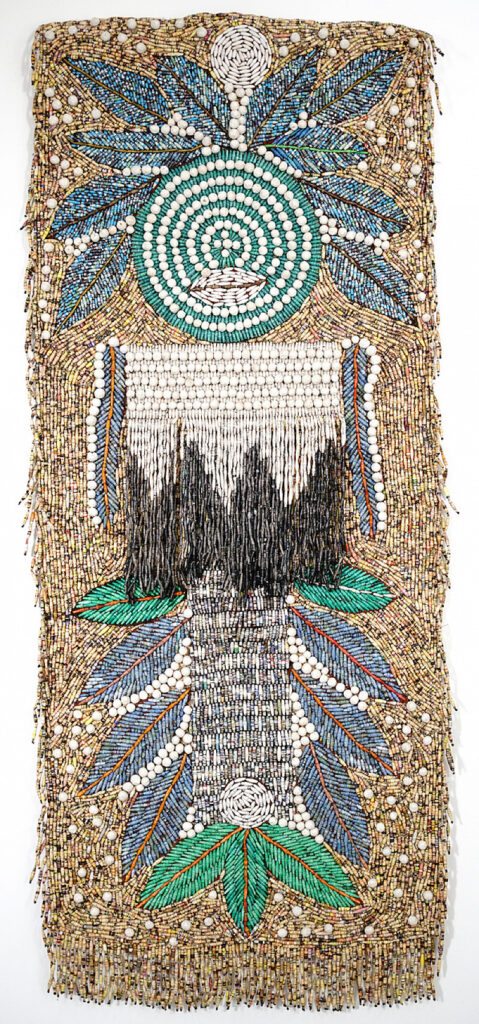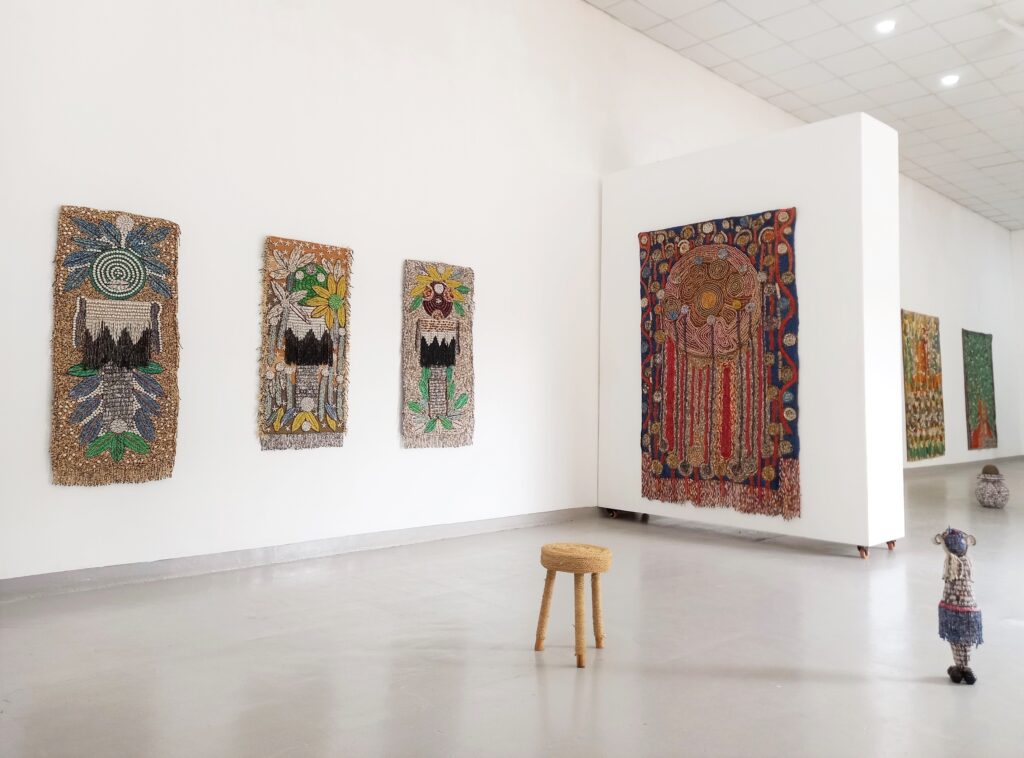
Gateja’s work is also very reminiscent of traditional African craftworks like basket and mat weaving. It must be a conscious choice for a goldsmith like himself who trained in Europe and comes back to search and discover better gold in traditional techniques that his forefathers perfected a long time ago. It is his way of keeping these practices alive but also adding his own spin to the magic.
Matt Kayem on the work of Sanaa Gateja from Uganda
A new day, 2020, Paper beads on bark cloth, 214 x 144cm
Sanaa Gateja: Radical Care
Afriart gallery opened its doors for the first time this year on 27th January to artist and master jeweler Sanaa Gateja’s work. The theme of the show, care and its title Radical Care perhaps coincided with the fever in the city – the removal of the remaining covid restrictions, mainly the curfew and opening of bars and social gatherings. The gallery had a sizeable attendance of enthusiastic art lovers, moving around, carefully but also carelessly, as though they were ex-convicts on parole. No curfew to worry about but treading with caution not to bump into the art and not to miss someone you haven’t seen in the last two years of lockdown. You don’t want to be labelled a snob in the art world, it’s a silent rule that is always broken though. I snaked around the room and almost never got time to take in the art on the walls as I was busy exchanging ‘happy new years’ and ‘long times’.

Radical Care, Arfiart Gallery, 2022, installation view
The pandemic not only affected our movements but the gallery roster too as we were accustomed to seeing Ronex Ahimbisibwe as the January artist. But maybe, the gallery curator, Lara Buchmann saw it fit to have Sanaa open up the year as his work blended in with the times. Sanaa’s work on show explores the aspect of care as fronted by philosophers and psychologists since the 1980s. If you hadn’t met Sanaa however, you would think he is a female as I now start to see a lot of that female energy in his work, the colors, the leaves, the concept and its attachment to women. Anyway, “we are currently living through the crisis of care”, argues Nancy Fraser, a decorated feminist philosopher. She continues that we are living in a time where the labor that builds the foundations of society goes both unrecognized and undervalued. She likens this to the way nature is treated in capitalist societies – as an infinite reservoir from which we can take as much as we want. Is this what the artist is alluding to? The leaves, the plants and the pregnant young girls he presents to us. Are we neglecting these? Do they need more attention than we give to them? We are taken deep into philosophy by Buchmann in the exhibition statement. And it makes for a much-needed connection as one delves deeper into the artist’s mind.

Early Days 1 2021, Paper beads and bark cloth on hand woven raffia,63-x-151-cm
Sanaa’s tapestries this time tell us that we need to take extra caution about ourselves, our bodies, minds and most especially that which is around us. Now that we’ve gone through a time where many have succumbed to the new disease, a time where our freedoms have been robbed from us with lockdowns. We need to heal, look at the beauty left around us, be thankful and take great care of it. And this care should change the present undesirable order. Sanaa shows it all to us in his work, ‘look at these stunning flowers and leaves’, he tells us. At the back, he knows that years to come, those who will be living won’t get the chance to experience what we have. In the triptych, Early Days 1-3, he sympathizes with the young ladies who have gotten pregnant during the pandemic, the school going females who have been away from school for two years. He tells me during our interview that they need care. Sanaa has always been supportive of women, for example, he employs them as assistants to help in the production of his work. It can’t get more feminist than this, there is a lot of oestrogen in the room. He makes them in his work and asserts that he loves women.
Gateja’s environmentalist concerns are not only in the choice of materials he uses which are largely biodegradable like the raffia, bark-cloth and paper. In the works, Blossoming, Conservation, Terraced Garden and Old Coffee Tree, his affinity to nature and its preservation resounds strongly. Once Upon A Time touches on cultural preservation and laments about the absence of traditional architecture in the countrysides.

Namuwongo, The Urban Series, 2021. Hard paper and seeds on bark cloth, -51x42cm
New in Sanaa’s modus operandi are small-scale works aside from the large-scale tapestries and three-dimensional sculptures. The small-scale works are from the Digital series and the Urban series. In the Digital series, he explores the now, the screens we hold and the future. The population outburst and congestion in the cities get his attention in the Urban series. He is interested in covering the informal settlement life in the urban centers and the fact that their inhabitants lack the basic needs to go about. These two series look different from the large works as they are of hard paper and paper mache. The three dimensional sculptures are blown up giant beads that form a family with which the artist playfully makes a Daddy bead, Mama bead, Auntie bead, Twin bead 1 & 2 and Baby bead. This could be an indicator that the artist has a high regard for the traditional family unit. He should, besides, that’s where care in its simplest but purest forms is bred. Also, the other standout in this show and probably one of the highlights was the Change 2 piece. It is a two-sided tapestry hang in the middle of the room. It’s the kind of work where the viewer should let themselves get lost in its repetitive pattern and lines and not worry about where to start from. Sanaa tells me that Change 1 is at the Museum of Arts and Design in New York and was produced in 2010. He continues that Change 2 probes the worth of change. “We are still imprisoned somehow”, he says. It is this flat and broadening tone in Sanaa’s work that makes one want to investigate more into it.

Radical Care, Afriart Gallery, 2022, installation view (left Early Days, 1, 2, 3)
Sanaa has lived up to his name and never disappoints with the craftwork. ‘Sanaa’ in Swahili means art and ‘kusana’ in the artist’s mother tongue Kinyarwanda means to craft or piece together. The works on display bear all the marks of successful craftworks. The symmetry, balance, abstraction are all impeccable even with a tricky material as paper beads. Gateja’s work is also very reminiscent of traditional African craftworks like basket and mat weaving. It must be a conscious choice for a goldsmith like himself who trained in Europe and comes back to search and discover better gold in traditional techniques that his forefathers perfected a long time ago. It is his way of keeping these practices alive but also adding his own spin to the magic.
